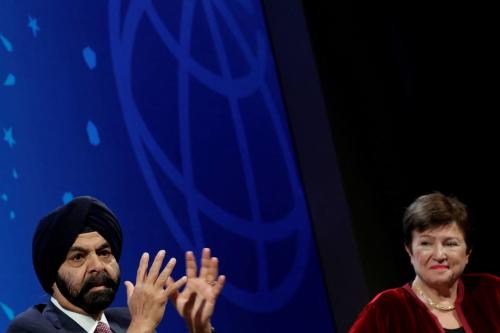Often we criticize reports for jumping to conclusions unsupported by the analysis. Yet in the case of the new review of World Bank public procurement efforts by the institution’s Independent Evaluation Group (IEG)—a veritable magnum opus at over 450 pages—the tables are turned. Despite the strong assertions in the analysis, the IEG’s recommendations fall short and do not adequately address the issues raised in the review.
To the IEG’s credit, it has undertaken an extensive and ambitious effort to look at the effectiveness of the World Bank’s procurement policies in advancing development. Together with the Bank’s recent report on procurement reform—a Proposed New Framework Phase I—and its extensive list of background papers, the IEG review offers a treasure-trove of information for development practitioners and policymakers on procurement—a topic that seldom gets such analytical attention. The timing of these reports is critical, as the World Bank and others worldwide are currently considering procurement policy reforms.
Multilateral procurement policies have led to many positive outcomes, helping to open developing-country markets to greater competition and transparency. But are these policies sufficient to meet the challenges and opportunities of today’s evolving development landscape? My reading of the evidence offers a storyline different from that presented by the IEG—one that indicates a need for very fundamental changes in policy and practice. There are four key areas in which the IEG report has missed the mark when drawing conclusions from its own analysis:
- Despite acknowledging the range of serious issues and challenges associated with the Bank adopting a broader set of procurement methods, the IEG finds the present policies “broadly adequate” and recommends a mere “fine-tuning…and clarification and amendment of guidelines.” The adoption of methods that were not applied effectively (if at all) in the past is indeed essential, as the IEG points out the needs of different sectors and country contexts. However, these different contexts require a greater level of discretion by staff and by client countries—discretion that the Bank has been reluctant to accept in the past. This implies a more fundamental reformulation of present policy. What may have been “adequate” in the past is clearly not sufficient for the present or the future.
- The IEG analysis further recognizes that an outcome-based approach requires the Bank to focus more attention on the upstream and downstream elements of the procurement process compared to what is currently devoted to the bidding process. Of particular importance is the downstream aspect of contract management, a critical phase in project implementation that can jeopardize even the best of bidding practices if not monitored carefully. The IEG recommendation, however, simply calls for a clarification of the responsibilities of sector specialists/technical experts, task team leaders and procurement staff in contract management. Actually addressing the shortfall in Bank policy and practice requires determining the trade-offs between resources directed at bidding versus contract execution, defining the technical options for such oversight and identifying the skills required. Merely getting the roles right is a small piece of such a major and necessary shift.
- The risk-averse culture in the Bank has been noted by many inside and outside the institution. As the IEG indicates, it is especially evident in procurement, with staff reluctant to apply the flexibility and judgment that is permitted within existing guidelines. Rather, the tendency is to push decisions up the bureaucratic chain of command. A key factor in this culture is the increased emphasis and uncertainties relating to anti-corruption. The IEG recommendations, however, ignore this critical issue and the relationship between anti-corruption related processes and procurement delays. Instead, the IEG recommendations with regard to procurement delays focus on raising the contract value threshold above which an automatic prior review by the Bank is required. Unless the overall risk-averse culture is addressed, the increase in thresholds will have a limited impact.
- Lastly, the IEG review lacks a crucial recommendation regarding procurement staffing at the World Bank. The combination of findings and the recognition of their importance as fundamental reforms imply a major challenge to the type of staff required by the World Bank. To move from a transaction-oriented policy to a broader systems focus, with the ability to apply a wide range of procurement approaches to different country contexts and sectors, necessarily represents a major change in staffing complement, skills and incentives structures.
Over the next six months, there will be extensive discussions on the types of procurement reforms and their implications for the World Bank, the multilateral development banks and all countries involved in this market. It is important, then, to be clear about what these reforms entail in terms of trade-offs, benefits and costs. The IEG’s work has contributed to the overall dialogue, but its recommendations do not adequately emphasize the fundamental nature of the required reforms.



Commentary
World Bank Evaluation Group Issues Procurement Review: Do the Conclusions Fit the Analysis?
December 23, 2013